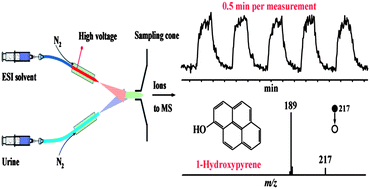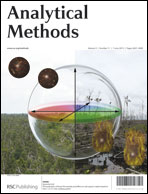Direct analysis of urinary 1-hydroxypyrene using extractive electrospray ionization ion trap tandem mass spectrometry†
Abstract
Fast detection (0.5 min) of 1-hydroxypyrene (1-OHP) in urine and hydrolyzed urine without pre-treatment has been successfully achieved by using extractive electrospray ionization ion trap tandem mass spectrometry (EESI-MS/MS) under optimized EESI and MS/MS conditions. Experimental results indicated that for MS/MS analysis the operating parameter of activation Q (AQ) was critical for 1-OHP fragmentation in collision induced dissociation (CID) experiments, and in the EESI process the primary ESI solvent was a key factor for extractive ionization of urinary 1-OHP. The limit of detection (LOD) and limit of quantification (LOQ) were 0.75 and 2.25 μM for both urine and hydrolyzed urine samples. A five-point working curve ranging from 2.29 to 22.91 μM for 1-OHP in urine or hydrolyzed urine was obtained (R2 = 0.9941 for urine and R2 = 0.9983 for hydrolyzed urine), and the relative standard deviations (RSD, n = 6) were 2.6–9.7% and 1.5–6.4%, respectively. The developed EESI-MS/MS method was validated by detecting 1-OHP in both urine and hydrolyzed urine samples. Recoveries were determined to >50% and 0.5 min was taken for each measurement, indicating that the proposed method is a promising strategy for high throughput analysis of urinary 1-OHP required for health risk assessment of exposure to polycyclic aromatic hydrocarbons (PAHs).


 Please wait while we load your content...
Please wait while we load your content...